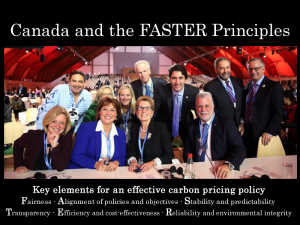Carbon pricing is widely accepted as the most cost-effective way to reduce greenhouse gas (GHG) emissions. However, where a Carbon pricing is widely accepted as the most cost-effective way to reduce greenhouse gas (GHG) emissions. However, where a well-designed carbon price falls short on regulating GHGs, complementary policies can be considered. For example, Canada’s Ecofiscal Commission identifies three specific areas of our economy where complementary policies may be warranted:[1] To complement carbon pricing, the following policies are supported by Pembina Institute[2] and/or Deep Decarbonization Pathways[3] and incorporated in the Pan-Canadian Framework:[4] Even when there appears to be a clear rationale for a complimentary policy, however, it is only worth proceeding if the policy is well designed and cost-effective. For example, the Ecofiscal analysis found subsidies for EVs in Quebec were costly and had little effect on demand, whereas regulated quotas for EV sales were much less costly and more effective.[5] The bottom line is that carbon pricing must be at the heart of any climate action plan, with additional GHG regulations implemented if they meet specific criteria that demonstrate complementarity. REFERENCES [1] “Supporting Carbon Pricing: Identifying complementary climate policies.” https://ecofiscal.ca/reports/supporting-carbon-pricing-complementary-policies/. Accessed 28 Jun. 2019. [2] “Report Download PDF – Pembina Institute.” 2 Sep. 2016, https://www.pembina.org/reports/race-to-the-front-english.pdf. Accessed 8 Aug. 2019. [3] “Pathways to deep decarbonization in Canada.” http://deepdecarbonization.org/wp-content/uploads/2015/09/DDPP_CAN.pdf. Accessed 8 Aug. 2019. [4] “on Clean Growth and Climate Change – Canada.ca.” 9 Dec. 2016, https://www.canada.ca/content/dam/themes/environment/documents/weather1/20161209-1-en.pdf. Accessed 8 Aug. 2019. [5] “Supporting Carbon Pricing: Identifying complementary climate policies.” https://ecofiscal.ca/reports/supporting-carbon-pricing-complementary-policies/. Accessed 28 Jun. 2019. Laser Talk: Complementary Policies to Carbon Pricing
Laser Talk: Complementary Policies to Carbon Pricing
Home » CCL Canada News » Laser Talk: Complementary Policies to Carbon Pricing












